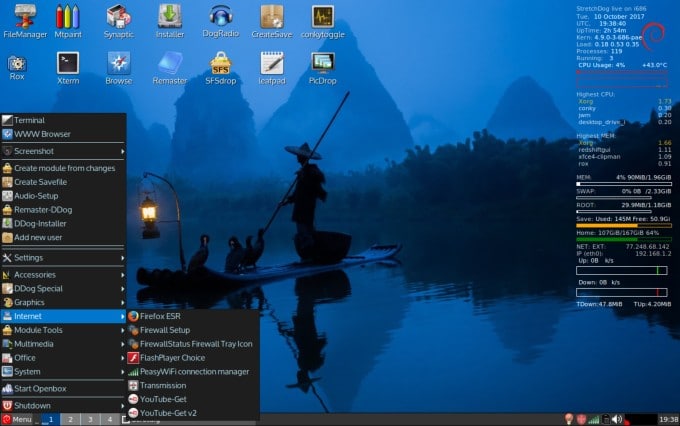
Some days ago the release of the new version of DogLinux was announced (Puppy Linux-style Debian LiveCD), built on top of the Debian 11 "Bullseye" package and designed for testing and repairing PCs and laptops.
The distribution stands out for including applications as GPUtest, Unigine Heaven, CPU-X, GSmartControl, GParted, Partimage, Partclone, TestDisk, ddrescue, WHDD, DMDE. The distribution allows you to check the performance of the computer, load the processor and video card, check the SMART HDD and NVMe SSD.
Main novelties of DogLinux

This new version of the distribution has been prepared with the updated Linux kernels 5.10.92 and 5.16.7, plus x86-64 kernels are built with EndlessOS intel-nvme-remap patch to make NVMe SSDs available on 3-5th Gen Intel Core i7/i8/i10 platforms with Intel RST Premium with Optane enabled in BIOS.
When booting with HWE kernel 5.16, the new Paragon NTFS3 driver is used by default instead of NTFS-3G, plus updated HWE stack is also included: libdrm 2.4.109, Mesa 21.3.5 (built with LLVM 11 to avoid duplication).
We can also find that the controller of NVIDIA has been updated to version 470.103.01 to support RTX 2050, MX550, MX570.
It is worth mentioning that layout size is optimized for use in copy2ram mode (allows you to remove the USB drive/network cable after downloading). In this case, only the squashfs modules that are used are copied to RAM. It contains three versions of proprietary NVIDIA drivers: 470.x, 390.x and 340.x, plus it mentions that the driver module needed for loading is automatically detected.
When running GPUTest and Unigine Heaven, laptop configurations with Intel+NVIDIA, Intel+AMD, and AMD+NVIDIA hybrid video subsystems are automatically detected and the necessary environment variables are set to run on a discrete graphics card.
Of the other changes that stand out from this new version:
- Added Chromium 98.0.4758.80 (official build) from Debian 11 repositories instead of Google Chrome.
- Realtek rtw88 driver with support for 802.11ac WiFi module RTL8821CE revision RFE4 is built for kernel 5.10
- Added a program to view information about the CPU-X system (built from git slice of 20220213).
- Updated program for copying faulty hard drives HDDSuperClone 2.3.2
- UEFI Update PassMark memtest86 9.4
- Updated DOS program HDAT2 7.4
- Firmware updated linux-firmware-20220209
- Construction Features:
- Booting in UEFI and Legacy/CSM mode is supported. Even over the network via PXE with NFS. From USB/SATA/NVMe devices, from FAT32/exFAT/Ext2/3/4/NTFS file systems. UEFI Secure Boot is not supported and should be disabled.
- For new hardware, there is an HWE boot option (live/hwe includes new Linux kernel, libdrm, and Mesa).
- For compatibility with older hardware, a live32 i686 version with a non-PAE kernel is included.
Finally If you are interested in knowing a little more about it, you can check the details in the following link
Download and get DogLinux
For those who are interested in being able to try this distribution, they should know that the system environment is based on Porteus Initrd, OverlayFS, SysVinit and Xfce 4.16. The pup-volume-monitor is responsible for mounting the drives (without using gvfs and udisks2). ALSA is used directly instead of Pulseaudio. Applied own script to solve problem with HDMI priority of sound cards.
You can install any software from the Debian repositories, as well as create modules with the necessary additional software. Activation of squashfs modules after system boot is supported.
The shell scripts and configurations can be copied to the live/rootcopy directory and will be applied on boot without the need to rebuild modules.
The work is done with root permissions. The interface is in English, files with translations are cropped by default to save space, but the console and X11 are set to display and change layouts using Ctrl + Shift. The default password for root is "dog", for "puppy" it is "dog". Modified scripts and configuration files are located in 05-customtools.squashfs.
Installation can be done using the installdog script on a FAT32 partition, using the syslinux and systemd-boot (gummiboot) bootloaders. Alternatively, out-of-the-box configuration files for grub4dos and Ventoy are provided.
It can be installed on the hard drive/SSD of a pre-sale PC/laptop to demonstrate performance. The FAT32 partition is then easy to remove, the script does not make any changes to UEFI variables (boot queue in UEFI firmware).
The size of live image downloaded from USB drives is 1,1 GB and can be downloaded from this link.